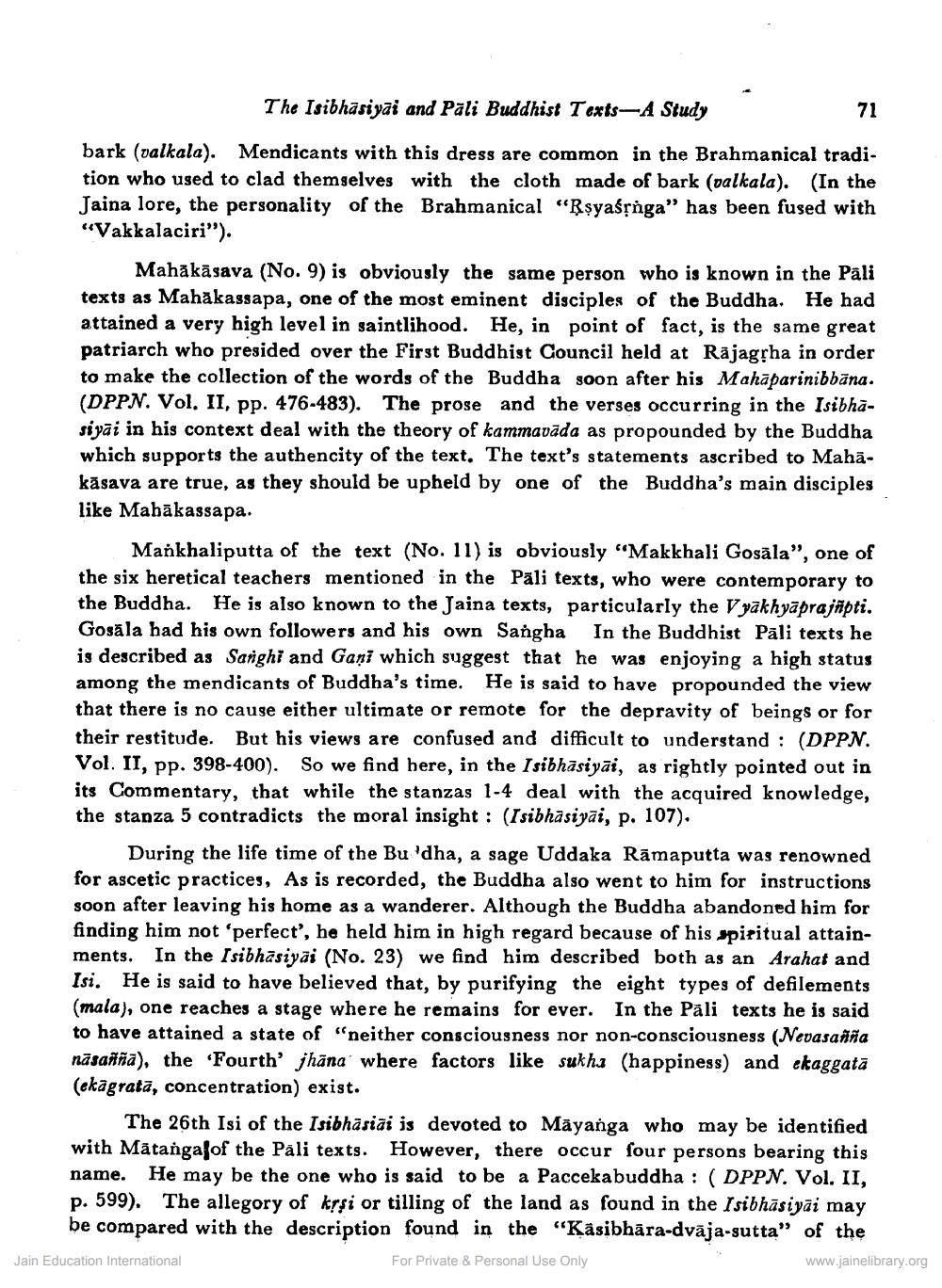Book Title: Isibhasiyai and Pali Buddhist Texts A Study Author(s): C S Upasak Publisher: Z_Aspect_of_Jainology_Part_3_Pundit_Dalsukh_Malvaniya_012017.pdf View full book textPage 4
________________ The Isibhâsiyai and Pali Buddhist Texts-A Study 71 bark (valkala). Mendicants with this dress are common in the Brahmanical tradition who used to clad themselves with the cloth made of bark (valkala). (In the Jaina lore, the personality of the Brahmanical “Rsyaśộnga" has been fused with “Vakkalaciri"). Mahākāsаva (No. 9) is obviously the same person who is known in the Pali texts as Mahakassapa, one of the most eminent disciples of the Buddha. He had attained a very high level in saintlihood. He, in point of fact, is the same great patriarch who presided over the first Buddhist Council held at Rājagļha in order to make the collection of the words of the Buddha soon after his Mahāparinibbāna. (DPPN. Vol. II, pp. 476-483). The prose and the verses occurring in the Isibhasiyāi in his context deal with the theory of kammavāda as propounded by the Buddha which supports the authencity of the text. The text's statements ascribed to Mahākāsava are true, as they should be upheld by one of the Buddha's main disciples like Mabākassapa. Mankhaliputta of the text (No. 11) is obviously “Makkhali Gosāla", one of the six heretical teachers mentioned in the Pāli texts, who were contemporary to the Buddha. He is also known to the Jaina texts, particularly the Vyakhyāprajñpti. Gosāla had his own followers and his own Sangha In the Buddhist Pāli texts he is described as Sanghi and Gani which suggest that he was enjoying a high status among the mendicants of Buddha's time. He is said to have propounded the view that there is no cause either ultimate or remote for the depravity of beings or for their restitude. But his views are confused and difficult to understand : (DPPN. Vol. II, pp. 398-400). So we find here, in the Isibhāsiyāi, as rightly pointed out in its Commentary, that while the stanzas 1-4 deal with the acquired knowledge, the stanza 5 contradicts the moral insight : (Isibhasiyai, p. 107). During the life time of the Bu 'dha, a sage Uddaka Rāmaputta was renowned for ascetic practices, As is recorded, the Buddha also went to him for instructions soon after leaving his home as a wanderer. Although the Buddha abandoned him for finding him not 'perfect', he held him in high regard because of his spiritual attainments. In the Isibhāsiyāi (No. 23) we find him described both as an Arahat and Isi. He is said to have believed that, by purifying the eight types of defilements (mala), one reaches a stage where he remains for ever. In the Pāli texts he is said to have attained a state of "neither consciousness nor non-consciousness (Nevasañña nāsaina), the Fourth' jhāna' where factors like sukhu (happiness) and ekaggatā (ekagratā, concentration) exist. The 26th Isi of the Isibhāsiai is devoted to Māyanga who may be identified with Mātangafof the Pali texts. However, there occur four persons bearing this name. He may be the one who is said to be a Paccekabuddha : ( DPPN. Vol. II, p. 599). The allegory of krşi or tilling of the land as found in the Isibhāsiyāi may be compared with the description found in the "Käsibhāra-dvāja-sutta" of the Jain Education International For Private & Personal Use Only www.jainelibrary.orgPage Navigation
1 2 3 4 5 6
